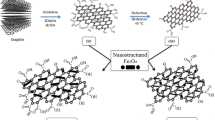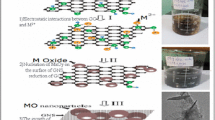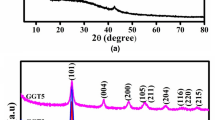Abstract
In this work, we report the synthesis of novel inorganic–organic hybrid nanomaterials (GO@Fe3O4 /CuPc) and GO@Fe3O4 /ZnPc) consisting of sheets of graphene oxide (GO) decorated by iron oxide nanoparticles (Fe3O4), the whole heterostructure functionalized with metallo-phthalocyanines (MPc, M≡Cu or Zn). First the synthesis of nanomaterial (GO@Fe3O4) was prepared by hydrothermal self-assembly process through the mixture of graphene oxide and Fe+2/Fe+3 salt solution. The metallo-phthalocyanines anchorage on the surface of nanosystem was lately performed by facile and effective ultrasonication method. The structure, composition and morphology of nanohybrids and intermediates were investigated by Fourier transform infrared spectroscopy, X-ray diffraction, thermogravimetric analysis, differential scanning calorimetry, UV–visible spectroscopy, scanning and transmission electron microscopy and impedance spectroscopy. All the results suggested that iron-based nanoparticles were successfully deposited onto graphene oxide sheet networks in the form of Fe3O4, forming nanospheres, decreasing in lattice defects of the GO sheets and dramatically increasing the dielectric properties of nanosystems. Nanomaterials presented saturation magnetization in the 52–58 emu/g and superparamagnetic behavior. It was observed that the values of dielectric constant decreased as a function of the amount of phthalocyanines in the nanomaterials. Therefore, because of their versatile magnetic and dielectric performances, the novel superparamagnetic hybrid nanomaterials, herein described, can be considered as potential for microwave devices.








Similar content being viewed by others
References
Xu Z, Hou Y, Sun S (2007) Magnetic core/shell Fe3O4/Au and Fe3O4/Au/Ag nanoparticles with tunable plasmonic properties. J Am Chem Soc 129:8698–8699
Selvan ST, Tan TTY, Yi DK, Jana NR (2010) Functional and multifunctional nanoparticles for bioimaging and biosensing. Langmuir 26:11631–11641
Oh JK, Park JM (2011) Iron oxide-based superparamagnetic polymeric nanomaterials: design, preparation, and biomedical application. Prog Polym Sci 36:168–189
Deriu MA, Popescu LM, Ottaviani MF, Danani A, Piticescu RM (2016) Iron oxide/PAMAM nanostructured hybrids: combined computational and experimental studies. J Mater Sci 51:1996–2007
Sarvari MH, Khanivar A, Moeini F (2015) Magnetically recoverable nanoPd/Fe3O4/ZnO catalyst: preparation, characterization, and application for the synthesis of 2-oxazolines and benzoxazoles. J Mater Sci 50:3065–3074
Mashhadizadeh MH, Talemi RP (2016) Synergistic effect of magnetite and gold nanoparticles onto the response of a label-free impedimetric hepatitis B virus DNA biosensor. Mater Sci Eng 59:773–781
Salihov SV, Ivanenkov YA, Krechetov SP, Veselov MS, Sviridenkova NV, Savchenko AG, Klyachko NL, Golovin YI, Chufarova NV, Beloglazkina EK, Majouga AG (2015) Recent advances in the synthesis of Fe3O4@AU core/shell nanoparticles. J Magn Magn Mater 394:173–178
Yazdani F, Fattahi B, Azizi N (2016) Synthesis of functionalized magnetite nanoparticles to use as liver targeting MRI contrast agent. J Magn Magn Mater 406:207–211
Mousa NM, Khairy M, Shehab MJ (2016) Nanostructured ferrite/graphene/polyaniline using for supercapacitor to enhance the capacitive behavior. Solid State Electrochem. doi:10.1007/s10008-016-3446-6
Barreto ACH, Maia FJN, Santiago VR, Ribeiro VGP, Denardin JC, Mele G, Carbone L, Lomonaco D, Mazzetto SM, Fechine PBA (2012) Novel ferrofluids coated with a renewable material obtained from cashew nut shell liquid. Microfluid Nanofluid 12:677–686
Hu F, Wei L, Zhou Z, Ran Y, Li Z, Gao M (2006) Preparation of biocompatible magnetite nanocrystals for in vivo magnetic resonance detection of cancer. Adv Mater 18:2553–2556
Antunes E, Rapulenyane N, Ledwaba M, Litwinski C, Chidawanyika W, Nyokong T (2013) The synthesis and characterisation of magnetic nanoparticles and their interaction with a zinc phthalocyanine. Inorg Chem Commun 29:60–64
Souza NDG, Freire RM, Cunha AP, da Silva MAS, Mazzetto SE, Sombra ASB, Denardin JC, Ricardo NMPS, Fechine PBA (2015) New magnetic nanobiocomposite based in galactomannan/glycerol and superparamagnetic nanoparticles. Mater Chem Phys 156:113–120
Singh K, Ohlan A, Pham VH, Balasubramaniyan RB, Varshney S, Jang J, Hur SH, Choi WM, Kumar M, Dhawan SK, Kong B-S, Chung JS (2013) Nanostructured graphene/Fe3O4 incorporated polyaniline as a high performance shield against electromagnetic pollution. Nanoscale 5:2411–2420
Liu P, Huang Y (2013) Synthesis of reduced graphene oxide-conducting polymers-Co3O4 composites and their excellent microwave absorption properties. RSC Adv 41:19033–19039
Yang Z, Huang R, Qi W, Tong L, Su R, He Z (2015) Hydrolysis of cellulose by sulfonated magnetic reduced graphene oxide. Chem Eng J 280:90–98
Al-Ghamdi AA, Al-Turki Y, Yakuphanoglu F, El-Tantawy F (2016) Electromagnetic shielding properties of graphene/acrylonitrile butadiene rubber nanocomposites for portable and flexible electronic devices. Compos B Eng 88:212–219
Zhang H, Jia S, Lv M, Shi J, Zuo X, Su S, Wang L, Huang W, Fan C, Huang Q (2014) Size-dependent programming of the dynamic range of graphene oxide—DNA interaction-based ion sensors. Anal Chem 86:4047–4051
Liu H, Deng L, Zhang Z, Guan J, Yan Y, Zhu Z (2015) One-step in situ hydrothermal synthesis of SnS2/reduced graphene oxide nanocomposites with high performance in visible light-driven photocatalytic reduction of aqueous Cr(VI). J Mater Sci 50:3207–3211
Yang Y, Asiri AM, Tang Z, Du D, Lin Y (2013) Graphene based materials for biomedical applications. Mater Toda 16:365–373
Dinari M, Momeni MM, Goudarzirad M (2016) Dye-sensitized solar cells based on nanocomposite of polyaniline/graphene quantum dots. J Mater Sci 51:2964–2971
Liu J, Cui L, Losic D (2013) Graphene and graphene oxide as new nanocarriers for drug delivery applications. Acta Biomater 9:9243–9257
Hu H, Lian H, Zu L, Jiang Y, Hu Z, Li Y, Shen S, Cui X, Liu Y (2016) Durable electromechanical actuator based on graphene oxide with in situ reduced graphene oxide electrodes. J Mater Sci 51:1376–1381
Wu Q, Chen M, Chen K, Wang S, Wang C, Diao G (2016) Fe3O4-based core/shell nanocomposites for high-performance electrochemical supercapacitors. J Mater Sci 51:1572–1580
Wang Y, Yang C, Cheng Y, Zhang Y (2015) A molecular dynamics study on thermal and mechanical properties of graphene-paraffin nanocomposites. RSC Adv 101:82638–82644
Yang J-H, Gao Y, Zhang W, Tang P, Tan J, Lu A-H, Ma D (2013) Cobalt phthalocyanine—graphene oxide nanocomposite: complicated mutual electronic interaction. J Phys Chem C 117:3785–3788
Gupta RK, Tuncer H, Al-Ghamdi AA, Yol S, Dere A, Yakuphanoglu F, Farooq WA (2015) Novel optical sensor based on zinc phthalocyanine. J Nanoelectron Optoelectron 9:709–713
Wan Y, Cong T, Liang Q, Li Z, Xu S, Peng Y, Luc D (2016) Facile in situ solvothermal method to synthesize ZnPc-MWCNTs composites with enhanced visible light photocatalytic activity. Ceram Int 42:2425–2430
Zhong J-P, Fan Y-J, Wang H, Wang R-X, Fan L-L, Shen X-C, Shi Z-J (2013) Copper phthalocyanine functionalization of graphene nanosheets as support for platinum nanoparticles and their enhanced performance toward methanol oxidation. J Power Sources 242:208–215
Oni J, Ozoemena KI (2012) Phthalocyanines in batteries and supercapacitors. Year J Porphyr Phthalocyanines 16:754–760
Alamin AHE, Altindal A, Altun S, Odabaş Z (2016) Highly efficient dye-sensitized solar cells based on metal-free and copper(II) phthalocyanine bearing 2-phenylphenoxy moiety. Dyes Pigm 124:180–187
Choi SA, Kim K, Lee SJ, Lee H, Babajanyan A, Friedman B, Lee K (2016) Effects of thermal preparation on Copper Phthalocyanine organic light emitting diodes. J Lumin 171:149–153
Linares-Flores C, Mendizabal F, Arratia-Pérez R, Inostroza N, Orellana C (2015) Substituents role in zinc phthalocyanine derivatives used as dye-sensitized solar cells. A theoretical study using density functional theory. Chem Phys Lett 639:172–177
Zhen L, Guan W, Shang L, Liu M, Liu G (2008) Organic thin-film transistor memory with gold nanocrystals embedded in polyimide gate dielectric. J Phys D 41:135111
Cakir D, Goksel M, Cakir V, Durmus M, Biyiklioglu Z, Kantekin H (2015) Amphiphilic zinc phthalocyanine photosensitizers: synthesis, photophysicochemical properties and in vitro studies for photodynamic therapy. Dalton Trans 44:9646–9658
Bechtold IH, Eccher J, Faria GC, Gallardo H, Molin F, Gobo NRS, De Oliveira KT, Von Seggern H (2012) New columnar Zn-phthalocyanine designed for electronic applications. J Phys Chem B 116:13554–13560
Zawadzka A, Plociennik P, Strzelecki J, Korcala A, Arof AK, Sahraoui B (2014) Impact of annealing process on stacking orientations and second order nonlinear optical properties of metallophthalocyanine thin films and nanostructures. Dyes Pigm 101:212–220
Yang J, Yan D, Jones TS (2015) Molecular template growth and its applications in organic electronics and optoelectronics. Chem Rev 115:5570–5603
Chandra V, Park J, Chun Y, Lee JW, Hwang I, Kim KS (2010) Water-dispersible magnetite-reduced graphene oxide composites for arsenic removal. ACS Nano 4:3979–3986
Hummers WS, Offeman RE (1958) Preparation of graphitic oxide. J Am Chem Soc 80:1339
Attanasi OA, Ciccarella G, Filippone P, Mele G, Spadavecchia J, Vasapollo G (2003) Novel phthalocyanines containing cardanol derivatives. J Porphyr Phthalocyanines 7:52–157
Barreto ACH, Santiago VR, Freire RM, Mazzetto SE, Sasaki JM, Vasconcelos IF, Denardin JC, Mele G, Carbone L, Fechine PBA (2013) Grain size control of the magnetic nanoparticles by solid state route modification. JMEPEG 22:2073–2079
Giri J, Pradhan P, Somani V, Chelawat H, Chhatre S, Banerjee R, Bahadur D (2008) Synthesis and characterizations of water-based ferrofluids of substituted ferrites [Fe1 − xB x Fe2O4, B = Mn, Co (x = 0–1)] for biomedical applications. J Magn Magn Mater 5:724–730
Karousis N, Sandanayaka ASD, Hasobe T, Economopoulos SP, Sarantopoulou E, Tagmatarchis N (2011) Graphene oxide with covalently linked porphyrin antennae: synthesis, characterization and photophysical properties. J Mater Chem 21:109–117
Pham VH, Pham HD, Dang TT, Hur SH, Kim EJ, Kong B-S, Kim S, Chung JS (2012) Chemical reduction of an aqueous suspension of graphene oxide by nascent hydrogen. J Mater Chem 22:10530–10536
Liu Y, Zhou J, Zhang X, Liu Z, Wan X, Tian J, Wang T, Chen Y (2009) Synthesis, characterization and optical limiting property of covalently oligothiophene-functionalized graphene material. Carbon 47:3113–3121
Glover AJ, Cai M, Overdeep KR, Kranbuehl DE, Schniepp HC (2011) In situ reduction of graphene oxide in polymers. Macromolecules 44:9821–9829
Słota R, Dyrda G, Hofer M, Mele G, Bloise E, Sole RD (2012) Novel lipophilic lanthanide bis-phthalocyanines functionalized by pentadecylphenoxy groups: synthesis, characterization and UV-photostability. Molecules 17:10738–10753
Shihao Xu, Zhao Yingguo, Zheng Fangcai, Zhang Yuanguang (2016) Hollow Fe3O4@mesoporous carbon core–shell microspheres for efficient sorption of radionuclides. J Mater Sci 51:2550–2557
Maia AOG, Meneses CT, Menezes AS, Flores WH, Melo DMA, Sasaki JM (2006) Synthesis and X-ray structural characterization of NiO nanoparticles obtained by gelatin. J Non-Cryst Solids 352:3729–3733
Bayer T, Cunning BV, Selyanchyn R, Daio T, Nishihara M, Fujikawa S, Lyth SM (2016) Alkaline anion exchange membranes based on KOH-treated multilayer graphene oxide. J Membr Sci 508:51–61
Tsangaris GM, Psarras GC, Kouloumbi N (1998) Electric modulus and interfacial polarization in composite polymeric systems. J Mater Sci 33:2027–2037. doi:10.1023/A:1004398514901
Wei ZWR, Liu X (2016) Preparation and dielectric properties of copper phthalocyanine/graphene oxide nanohybrids via in situ polymerization. J Mater Sci 51:4682–4690
Li J, Wei J, Pu Z, Xu M, Jia K, Liu X (2016) Influence of Fe3O4/Fe-phthalocyanine decorated graphene oxide on the microwave absorbing performance. J Magn Magn Mater 399:81–87
Acknowledgements
This work was supported by FUNCAP, CAPES and CNPq (Brazilian agencies).
Author information
Authors and Affiliations
Corresponding author
Rights and permissions
About this article
Cite this article
da Costa Júnior, A.E., Mota, J.P.F., Pontes, S.M.A. et al. A self-assembly of graphene oxide@Fe3O4/metallo-phthalocyanine nanohybrid materials: synthesis, characterization, dielectric and thermal properties. J Mater Sci 52, 9546–9557 (2017). https://doi.org/10.1007/s10853-017-1133-3
Received:
Accepted:
Published:
Issue Date:
DOI: https://doi.org/10.1007/s10853-017-1133-3




